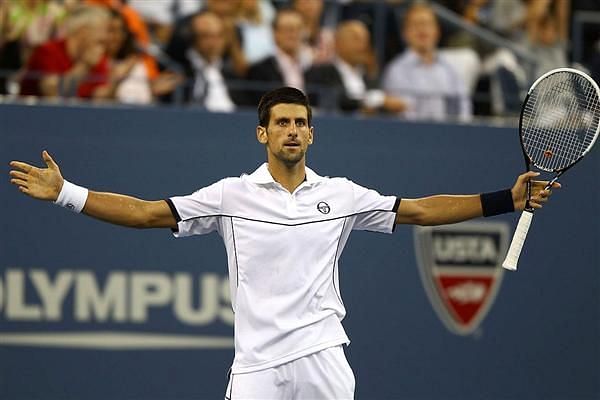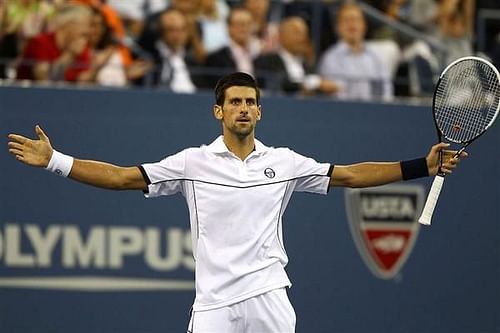
2011: The year Novak Djokovic single-handedly dismantled the ‘Fedal’ duopoly in men’s tennis
Novak Djokovic has answered all the critics and risen to the big stage once again, winning Wimbledon by creating an astounding 100 break point chances and defeating World #1 Rafael Nadal in a truly captivating, marathon 5 set semifinal. In doing so, Djokovic has also broken the Federer-Nadal or ‘Fedal’ duopoly in Grand Slam events, which started at the Australian Open of 2017.
Now, it is worth remembering his 2011 season, where he first took the tennis world by storm. That was the year the Serb announced himself as a force to reckon with on the big stage, shattering the ‘Fedal’ duopoly in men’s tennis.
Djokovic accrued a 10-1 head-to-head record against Federer and Nadal in 2011. In the process, he produced some top notch tennis and matches that will remain in memory for a long, long time.
Furthermore, Djokovic also recorded one of the longest win streaks (43 matches in a row) and one of the best starts to a season ever, going 41-0 until he lost to Federer in the French Open semifinal.
Djokovic's dominance on clay was unforeseen and, in my opinion, the most shocking and impressive feature of his 2011 campaign. The way he cracked the code with regard to Nadal’s game was mind-boggling and unprecedented.
The Serb captured two straight sets victories against Nadal on his beloved clay in Madrid (Nadal’s home court) and Rome. He won 6-4, 7-5 and 6-4, 6-4 in the finals of those two high profile Masters events respectively.
Nadal seemed to have no answer for Djokovic’s blistering, deep and consistent backhand groundstrokes which seemed to corner him on the ad side of the court, eventually making room for a perfectly executed down-the-line backhand winner. Playing Djokovic that year was almost like playing a wall as the Serb just never seemed to miss.
In other words, Djokovic was beating Nadal at his own game, in a battle of attrition.
However, the one single moment which is crisply indicative of the ice in his veins, of his impeccable prowess and boundless confidence, was his return of serve against Federer in the US Open semifinal.
Djokovic had already made a comeback after being 2 sets to love down, but he again found himself trailing in the fifth set, this time facing two match points. But down 3-5, 15-40 in the fifth set, Djokovic returned a serve out wide on to his forehand, blazing past the Federer forehand and making a statement with an immaculate return winner.
From that point on Federer failed to win a single game and was broken twice by the Serb, losing 7-5 in the fifth.
'Smiling in the face of adversity' is probably the most accurate phrase when it comes to describing the composure and confidence exuded by the Serb in that moment, and also throughout the rest of the season.
Djokovic won three out of four Grand Slams and five out of nine Masters titles, accumulating a phenomenal 70-6 (92.5%) record for that season.

Many would argue that Federer’s 2006 season, where the Swiss Maestro boasted a phenomenal 92-5 (94.84%), is more impressive than Djokovic’s 2011 season. That is a debate I do not wish to shed light upon extensively in this piece.
However, I will just say that the quality of opposition faced by Djokovic in 2011 was significantly higher than that faced by Federer in 2006.
Moreover, when Federer faced the World #2, Rafael Nadal that year, he only managed one victory in their five meetings. It is also worth noting that by any and every metric, Nadal was much more of an all-surface and complete player in 2011 as compared to 2006, having completed his Career Slam in 2010.
Djokovic faced the World #2 Nadal six times in 2011, winning every meeting, including two on clay, and dropping only six sets - with two of the matches being the best-of-five sets format.
The Serb ran out of gas towards the end of a remarkable and historical season. But up until the US Open, Djokovic’s backhand was absolutely on fire, causing huge problems for Nadal (even on clay) and Federer.
A big jump was observed in his serve numbers too. Djokovic served 282 double faults in 2010 but that number dropped drastically to 114 in 2011. His return of serve was also statistically the best on tour for that year, as he won 38.8% of return games and converted 48.3% of break points.
14-time Grand Slam champion Pete Sampras, another legend in the GOAT debate, hailed Djokovic’s 2011 season as quite possibly the greatest ever. Nadal was also full of praise for his rival, saying that Djokovic’s game was the highest level of tennis he had ever seen. John McEnroe added that Djokovic was having the greatest year in the history of the sport.
It is difficult to say with certainty whether Djokovic’s 2011 season was the best ever. However, I think it is safe to say that it was probably one of the most impactful and history-altering seasons in the sport, one that may even go on to shape the GOAT debate at the end of the Big 3’s respective careers.